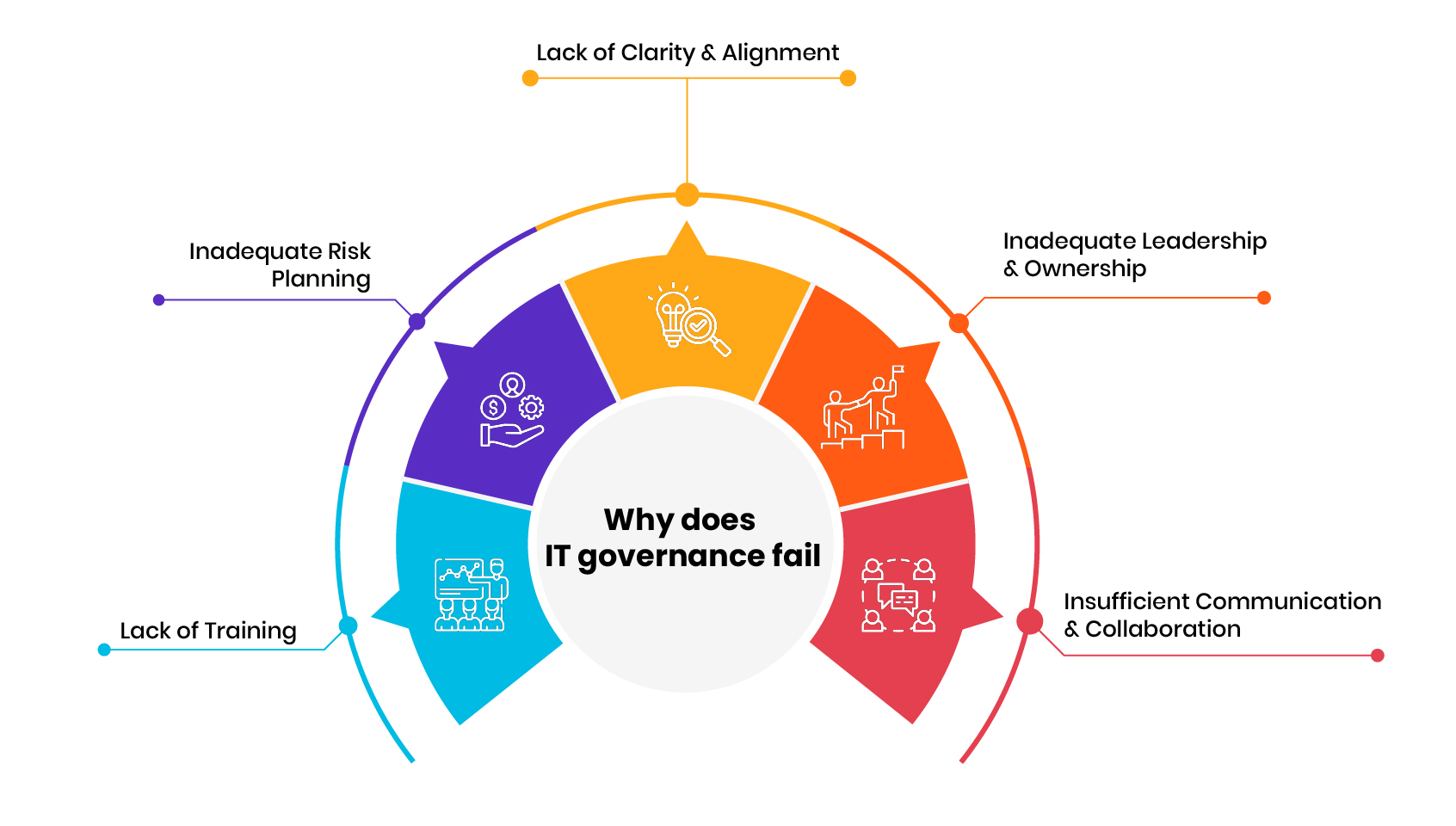
Governance policies are the anchor of the ship, guiding, charting the course, making course corrections, and ensuring you are on the right path. The policies, procedures, and practices of IT governance are the safety net of any organization and they also help in compliance with relevant regulations and standards. It should be a representation of your organization’s vision and mission, aligning with your business objectives. Managing and monitoring IT assets and data is crucial to maintaining security and ensuring IT investments are in coherence with business goals of the organization.
Why is IT governance important?
IT governance is a method of achieving your goals and objectives through productive and streamlined use of information technology in an organization. It is a subset of corporate governance that helps in creating monetary value out of your IT investments. Being at the top of your game entails being proactive by looking out for new opportunities, minimizing redundancies, and optimizing costs. With the vulnerability of IT security, governance policies offer accountability of decisions and actions. It also comes in handy while handling security threats, data breaches, and regulatory compliance; basically, identifying and mitigating risks. Another aspect is optimizing IT resources, including hardware, software, and teams, to ensure they are utilized optimally. IT governance also helps with tracking metrics and reporting mechanisms to measure performance and evaluating IT initiatives. These policies are a blueprint that minimizes cost and enhances value. Management based on strategy is the way to go about the governance of technology.
Despite knowing the value of IT governance, many organizations fail. Let’s look at some reasons which render IT policies ineffective:
Reasons IT governance fails

Lack of Clarity and Alignment: One of the most common reasons for IT governance failure is lack of clarity and alignment between IT and business objectives. IT governance frameworks like COBIT, ITIL, and ISO 38500 provide guidance for implementation, but they do not provide a one-size-fits-all solution because the IT governance needs may not be the same for all organizations. Companies need to customize their approach to fit their unique business objectives, risk profile, and organizational structure. IT governance should not be implemented in isolation, but should be integrated with the organization’s overall strategy and decision-making processes. If the IT governance objectives are not clearly defined and aligned with business objectives, the implementation is as useless as using glue to fix a nail on the wall.
Inadequate Leadership and Ownership: Another major reason for IT governance failure is the lack of leadership and ownership. IT governance should not be viewed as a one-time project, but as an ongoing process that requires continuous involvement and adaptation to changing business needs. Organizations need to have a clear governance structure with defined roles and responsibilities for IT governance. It must be championed by senior executives, who act as a lighthouse, providing guidance, support, and a clear vision to support the journey of IT governance. The ownership and accountability would provide the right structure for reliable governance, seeing it through success.
Insufficient Communication and Collaboration: IT governance involves multiple stakeholders, including business leaders, IT leaders, and other stakeholders, such as risk management and compliance teams. This can be a breeding ground for misinformation, causing detrimental issues. All teams and departments of the organization need to be on the same wavelength and understand the business objectives connected to IT governance. Working in silos can be a big reason for governance failure. IT department needs to understand the overarching business goals while leaders need to be aware of the overarching technical details of IT governance and they must work in tandem, foster a culture of collaboration to maximize the results.
“In many cases, IT teams are viewed as separate entities rather than integral parts of the overall organization. This siloed approach can lead to misunderstandings and misaligned priorities, ultimately resulting in failed IT projects and initiatives,” says Vaibhav Kakkar, CEO of Digital Web Solutions.
Lack of Training: IT Governance is a complex process to monitor and manage. This can cause issues between the teams who need to be onboard and ally with all the policies and procedures, as much as the leaders who decide on these policies. Cultural resistance to change can be an issue that becomes an impediment to seamless governance. Trust issues, siloed approach, lack of expertise can be other reasons for failure, thus, the teams need to be trained and consulted to enable smooth compliance with IT governance.
Inadequate Risk Planning: Prior to launching any policies, the CIOs must identify the risks and define how to measure it. Hindsight wouldn’t do any good if you consider risks after implementing IT governance policies. During the creation of policies, you must consider attainable goals that align with strategic objectives or it’ll result in a vulnerable governance system which is prone to risks like uptime constraints, technical issues, customer rejection, discontinuity, etc. Thus, leaders need to make risk mitigation a key point in their IT governance.
What can you do to improve?
Operational Visibility: The leaders need to have operational visibility after CIOs have created an extensive governance plan. Not all leaders can access and get the hang of the policies and procedures, which can have a dysfunctional impact on the business.
Aligning IT Governance with Business Governance: IT governance should not be an isolated endeavour, where the endgame is to finish a task as soon as possible, neglecting other business units. Legal, information risk management, and compliance teams should also be on the same page to meet the strategic goals set by the business.
New Methods to Quantify Progress: Measuring IT governance through SLAs is the old way. The new way should be for IT governance to concentrate on leading indicators that forecast future investments and expenditures. The metrics could include profit margin, customer satisfaction, revenue growth, revenue per client, and client retention rate.
Data as an Asset: Data isn’t a piece of possession which just creates cost while acquiring, treating, and storing. It’s a precious asset which can be monetized in various ways. It can inform good business decisions, create digital innovation and improve customer service.
“When you’re operating at a huge scale and need to maintain a high level of trust from your customers, you must have a robust data governance policy in place to protect your most sensitive data assets,” says Matthew Ramirez, serial entrepreneur and investor featured in Forbes 30 under 30.
The potential benefits of a robust and successful IT governance policy are visible and backed up by research. But because of the above-mentioned reasons, CIOs and other leaders fail to implement or manage the right policies. Once the leadership figures out what’s working and what isn’t, the path to impactful IT governance becomes clear and easy to follow.
We have solved various business challenges faced by global enterprises and delivered excellence over the years. Our aim was not only to deliver quality innovation but also to guide them to make the most of that innovation in a safe and sustainable way. So, we know a thing or two about corporate and IT governance. Talk to our experts and pick their brain over a coffee and they might have just the right solution for your business challenges: info@qentelli.com

